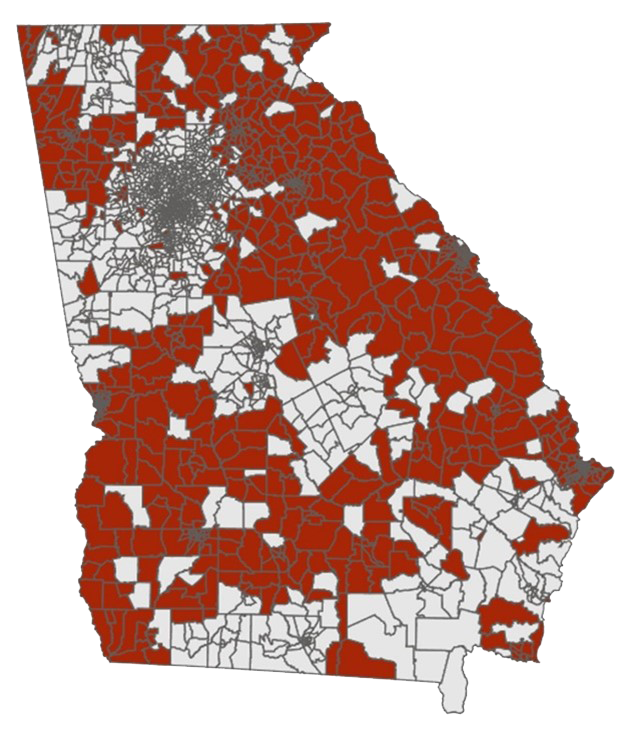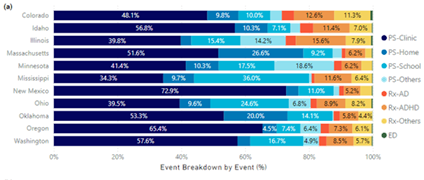Mental Health disorders are prevalent among children in the United States, disproportionately affecting those living in poverty or involved in the child welfare system. Medicaid, the largest public insurance program in the U.S., provides essential coverage for millions of low-income children and foster youth. With its broader mental health benefits compared to most private insurers, Medicaid plays a critical role in financing, organizing, and delivering child mental health services. Despite its importance, systemic challenges like workforce shortages, access barriers, and adherence to clinical guidelines persist, demanding targeted solutions.
What We Do - Selected Projects
Access to Mental Healthcare Services
Challenge: The Health Resources and Services Administration (HRSA) projects a national shortage of at least 50,000 mental health providers by 2030. This shortage, coupled with barriers such as transportation issues and parents’ inability to take time off work, often results in inadequate or missed mental health care. To overcome challenges in healthcare access, particularly for psychosocial services, federal and state policies require health systems to establish network adequacy standards to ensure service providers are accessible (e.g., reasonable travel distance) and available (e.g., reasonable wait time) MH providers.
Research: The focus of this research is to develop and apply rigorous methodologies to evaluate access to mental healthcare services with respect to various policies targeting improvement in access. The accompanying figure displays the shortage areas identified using a simulation access model applied to the state of Georgia.

Comparing Treatment Engagement Under Different Care Settings
Policy Impact: Recent policies, such as the Affordable Care Act and state-level reimbursement initiatives, have expanded the delivery of mental health services to community settings, including schools and homes. The 2014 reversal of the "free care" rule enabled Medicaid billing for school-based services. These policies made it possible for clinicians from MH organizations to deliver and bill for MH services in the community settings, including in-home and in-school, particularly targeting treatment for Medicaid-insured children.
Research: In this project, we consider different outcomes to compare the engagement in mental healthcare delivered in different settings, comparing community-based (in-home and in-school) to the traditional setting, in-clinic delivery with the distribution displayed in the accompanying figure for 11 states.

Engagement in psychosocial services among youth
Background: Prior studies have identified low rates of engagement in mental health (MH) services among Medicaid-enrolled children in clinic settings. Yet, little is known about whether the delivery of in-home MH care (where the clinician travels to the child’s home) improves engagement for this population.
Research: This study examines the association between the delivery of in-home psychosocial care and engagement in care among Medicaid-enrolled youth.
Adherence to Recommended Care Guidelines for Preschool-Aged Children Diagnosed with ADHD
Background: Attention-deficit/hyperactivity disorder (ADHD) is the most common neurodevelopmental disorder in childhood. Clinical guidelines recommend behavior therapy as the first-line treatment for preschool-aged children.
Objective: Evaluate the patterns of services received by Medicaid-enrolled children aged 2–5 with ADHD to determine adherence to recommended behavior therapy protocols over time.
Provider-level Caseload of Psychosocial Services for Children:
Issue: A significant proportion of Medicaid-insured children do not receive recommended psychotherapy, partly due to low provider participation in Medicaid.
Analysis: This study estimates the annual caseloads of providers, practices, and clinics offering psychosocial services to Medicaid-enrolled children, providing a clearer picture of service supply limitations.
Publications
Published by the Health Analytics Group
Kim, D., Cuffe, S.P.,Naylor, M.W., Keskinocak, P., Serban, N. (2024) "Adherence to Clinical Practice Guidelines and FDA Approved Psychotropic Medication to Treat Medicaid-insured Children with ADHD", Psychiatric Services, 75(11):1151-1156.
Cummings, J., Shellman, M., Stein, B., Asplund, J., Lin, H., Serban, N. (2022) "Association between in-home services and engagement in psychosocial services among Medicaid-enrolled youth", Journal of the American Academy of Child & Adolescent Psychiatry, 61(11), pages 1351-1361.
Harati, P., Cummings, J., Serban, N. (2020) "Provider-level Caseload of Psychosocial Services for Medicaid-Insured Children", Public Health Reports, 135(5):599-610.